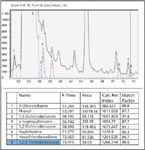Using Solid Phase Microextraction (SPME) and Person Portable GC–MS for Trace Level Detection of Selected Volatile Organic Chemicals in Air
CUSTODION SPME Syringes provide a simple, low cost methodology to collect and introduce samples to an analytical instrument. The low cost and convenience of SPME allows multiple samplers to be deployed simultaneously.
CUSTODION™ SPME Syringes provide a simple, low cost methodology to collect and introduce samples to an analytical instrument. The low cost and convenience of SPME allows multiple samplers to be deployed simultaneously. When coupled with the TRIDION™-9 GC–MS samples covering a wide boiling point range can be analyzed in as little as 3 min per run.
Sample concentrations can vary greatly from locations in or near industrial environments to surrounding residential environments that are in close proximity. SPME samplers can be setup to cover a wide area, and sampling times adjusted based on anticipated concentrations. In this application the detection capabilities of the TRIDION-9 and SPME are demonstrated for a number of analytes at approximately 1 part per billion (ppb) v/v in air.
Experimental Conditions
A 10 L Tedlar™ bag was spiked with a mixture of volatile organic compounds at ~1 ppb. Concentrations were corrected for atmospheric pressure and temperature using US EPA method 10-2.4. The analytes were extracted from the gas phase at ambient temperature for 60 min using a CUSTODION™ SPME syringe with a 65 µm polydimethylsiloxane/divinylbenzene (PDMS/DVB) fiber.
Following sample extraction, the SPME syringe was inserted into the TRIDION-9 GC-TMS injection port where the analytes were desorbed into a split-splitless injector (270 °C) coupled with a low thermal mass, capillary GC column (MXT-5, 5 m × 0.1 mm, 0.4 µm df). After an initial 10 s hold at 50 °C, the GC temperature was increased at 2 °C/s to 270 °C for a total run time of 1 min 30 s. The capillary GC is coupled to a TMS detector having a mass range of 43–500 m/z.
Results
Figure 1 shows the GC-TMS analysis of the ~1 ppb sample, illustrating the total ion chromatogram and individual ion traces for the extracted target compounds. Even with what is supposed to be a relatively clean sample, like one prepared in a Tedlar™ bag, detection and identification at trace levels can be problematic. Tedlar™ bags contain two major known contaminates N,N-Dimethylacetamide and Phenol. The target compounds were automatically identified by deconvolution software in the presence of these large interfering compounds.

Figure 1: Total ion chromatogram, extracted ion chromatograms, and results table.
Conclusions
The CUSTODION SPME Syringe and TRIDION-9 GC-TMS are uniquely suited for rapid onsite analysis. The ease of use, low cost of SPME and the high speed analysis of the TRIDION-9 GC-TMS allows for an unprecedented number of samples to be processed. This high speed analytical capability provides the information when and where it is needed to make in-field decisions. Wide concentration ranges can be accommodated with SPME by simply adjusting the sampling time.
Acknowledgements
Torion® , TRIDION™ and CUSTODION™ are trademarks of Torion Technologies Inc. The CUSTODION SPME Syringes are manufactured and sold under license from SUPELCO under U.S. Patent 5,691,206, and/or any divisions, continuations, or revisions thereof.
Torion Technologies Inc.
796 East Utah Valley Drive, Suite 200, American Fork, UT 84003
tel. (801) 705-6600, fax (801) 705-6649
Website: www.torion.com

Separation of Ultra-Short and Long Chain PFAS Compounds Using a Positive Charge Surface Column
December 11th 2024A separation of ultra-short and long chain PFAS (C1-C18) is performed on a HALO®PCS Phenyl-Hexyl column along with a HALO®PFAS Delay column which demonstrates excellent retention for both hydrophilic and hydrophobic analytes.

.png&w=3840&q=75)

.png&w=3840&q=75)



.png&w=3840&q=75)



.png&w=3840&q=75)













